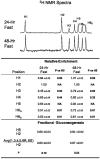Complicating factors in the application of the "average method" for determining the contribution of gluconeogenesis
- PMID: 18523054
- PMCID: PMC2992835
- DOI: 10.1152/japplphysiol.90406.2008
Complicating factors in the application of the "average method" for determining the contribution of gluconeogenesis
Figures

Comment on
-
Measurement of gluconeogenesis using glucose fragments and mass spectrometry after ingestion of deuterium oxide.J Appl Physiol (1985). 2008 Apr;104(4):944-51. doi: 10.1152/japplphysiol.00752.2007. Epub 2008 Jan 10. J Appl Physiol (1985). 2008. PMID: 18187615
References
-
- Burgess SC, Nuss M, Chandramouli V, Hardin DS, Rice M, Landau BR, Malloy CR, Sherry AD. Analysis of gluconeogenic pathways in vivo by distribution of 2H in plasma glucose: comparison of nuclear magnetic resonance and mass spectrometry. Anal Biochem. 2003;318:321–324. - PubMed
-
- Burgess SC, Weis BC, Jones JG, Smith E, Merritt ME, Margolis D, Sherry AD, Malloy CR. Noninvasive evaluation of liver metabolism by 2H and 13C NMR isotopomer analysis of human urine. Anal Biochem. 2003;312:228–234. - PubMed
-
- Chacko SK, Sunehag AL, Sharma S, Sauer PJJ, Haymond MW. Measurement of gluconeogenesis using glucose fragments and mass spectrometry after ingestion of deuterium oxide. J Appl Physiol. 2008;104:944–951. - PubMed
-
- Chandramouli V, Ekberg K, Schumann WC, Wahren J, Landau BR. Origins of the hydrogen bound to carbon 1 of glucose in fasting: significance in gluconeogenesis quantitation. Am J Physiol Endocrinol Metab. 1999;277:E717–E723. - PubMed
-
- Jones JG, Solomon MA, Cole SM, Sherry AD, Malloy CR. An integrated 2H and 13C NMR study of gluconeogenesis and TCA cycle flux in humans. Am J Physiol Endocrinol Metab. 2001;281:E848–E856. - PubMed
Publication types
MeSH terms
Substances
Grants and funding
LinkOut - more resources
Full Text Sources
Medical

